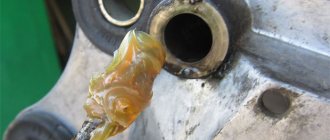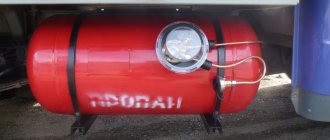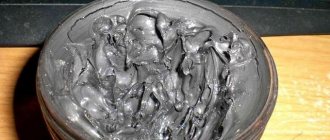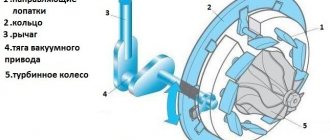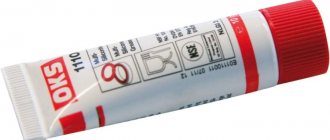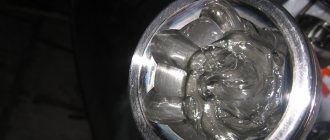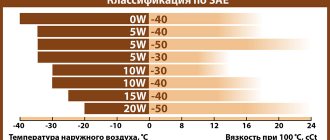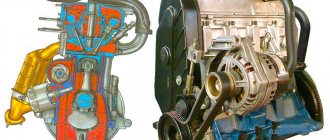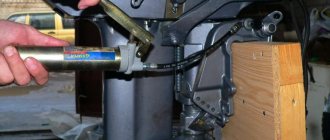What is Litol 24 lubricant?
Externally, Litol 24 lubricant is a homogeneous ointment from light yellow to brown in color (depending on the manufacturer and the base oil used). Performed in accordance with GOST 21150-87 .
In accordance with it, it is an anti-friction, multi-purpose, water-resistant lubricant intended for use in friction units of wheeled and tracked vehicles, industrial equipment and ship mechanisms for various purposes, operating at temperatures from -40°C to plus +120°C (short term up to +130°С). “Litol 24” lubricant is made by thickening a mixture of mineral oils with lithium soaps of technical 12-hydroxystearic acid with the addition of additives (anti-oxidant and viscosity).
Litol lubricant was developed in the 70s of the 20th century at the Central Institute of Aviation Fuels and Oils (CIATIM). It replaced materials such as CIATIM-201, 202 and 203.
Externally, Litol is a homogeneous ointment. Depending on the manufacturer and the raw materials used, its color can range from light yellow to brown depending on the manufacturer. The material is manufactured in accordance with GOST-21150-87.
In terms of composition, Litol is one of the simplest greases. It is based on a mineral base oil, thickened with lithium soap, with the addition of viscosity and antioxidant additives.
You should not purchase lithols in blue, green and other shades. Most likely they are made from low-quality raw materials according to specifications. As mentioned above, the lubricant according to GOST has a color from light yellow to brown.
Appearance and color
Lithium soap lubricants come in different colors. This parameter depends on the additives and dyes introduced by the manufacturer. Car owners mention white and burgundy (cherry), blue and green Litol. However, according to the standard, the spectrum of its shades is amber: it starts with light yellow and ends with brown.
An uncharacteristic color should alert you: either this is not Litol, or its composition does not meet the standards.
In the USSR, the lubricant was transparent. Changing and adding components affects this characteristic - the material becomes cloudy. The transparency of modern Litol may vary between different manufacturers, but does not affect the properties of the product.
Consistency
Lubricants of the lithol family are homogeneous and dense.
Consistency according to ISO 2137 – semi-solid.
The contents of the package resemble a thick ointment and look like Vaseline or boiled condensed milk. The original Litol's viscosity characteristics tend to be NLGI class 3.
Main properties of Litol 24
In addition to the main task: lubricating rubbing parts, it can act as protection against corrosion (unless the coating strength is low). In addition, there are other useful consumer properties:
- the material is inexpensive, since not the best raw materials are used in production (according to the residual principle);
- Litol 24 Lux is not demanding on the conditions of use: the characteristics are stable at any temperature and ambient humidity;
- does not wash off with water, regardless of temperature (resistant even to boiling water);
- good adhesion: Litol24 RK can be removed only by mechanical action or with the help of strong solvents;
- Electrical conductivity tends to zero: grease can be used in electrical connectors to protect against moisture ingress.
However, there are also disadvantages:
- flammable lubricant: this requires certain conditions of storage and use;
- the composition does not contain additives that increase the wear resistance of parts;
- thick lubricant accumulates external dust, including abrasive dust;
- does not maintain the specified characteristics under welding loads.
Lubricant composition
As already mentioned, Litol 24, manufactured according to GOST 21150 87, consists of a residual base cleared of paraffins (up to 50%). We can say that the material for production is waste from the oil refining industry.
In addition, the composition includes up to 40% mineral oil. According to GOST technology, it is unacceptable to use purified waste, only “first-mined” raw materials, even the cheapest ones.
The so-called lithium soap (lithium 12-hydroxysterate) 10%-15% is used as a thickener. A small percentage of additives: antioxidant, viscosity - to increase density.
Litol 24 – what is it for, video
Standards and GOSTs
The manufacturing technology, composition and properties of lithium lubricants are regulated by state standards or technical specifications: for example, Litol 24 - GOST 21150-87 (reissued as GOST 21150-2017 ). The same standard describes the modification of Litol-24RK, intended for the preservation of friction units.
Specifications
- NLGI – 3;
- DIN 51 502 – K3K-40.
Tolerances
- MVK Gosstandart of the Russian Federation No. 814/422;
- OEM approval FIAT-VAZ 55588.
Packing and storage
Litol-24 is packaged in plastic, metal containers, and cardboard drums. Standard container volume: buckets 18 kg and barrels 180 l . In addition, the lubricant is often packaged in sealed plastic containers with a capacity of 0.9, 2.2 and 10 kg .
The material should be stored away from open sources of fire and heating appliances. The shelf life stated by the manufacturer is 5 years .
Advantages and disadvantages
Lubricant is used in various fields, so it would be a good idea to familiarize yourself with its advantages and disadvantages. Especially when you consider that the composition is almost a century old.
Affordable price and wide distribution.
Chemical and mechanical stability - the material feels confident in any conditions.
This is interesting: Design of the master brake cylinder of a passenger car and replacement of the repair kit
Neutral to moisture - immune to even boiling water.
Excellent adhesion - holds on any parts.
Zero electrical conductivity - used when servicing rubbing parts of electrical equipment.
Independence from temperature fluctuations - the properties of the characteristics are maintained in cold and hot climates.
Lack of additives that increase wear resistance of parts. As a comparison: the scuffing index of transmission oil TM5-18 is 58 , Litola-24 is 28 .
Low performance under welding loads.
The material is flammable, which requires appropriate storage conditions.
Negative aspects also include the fact that the lubricant retains abrasive particles and poorly removes heat from the rubbing elements of the mechanism. Accordingly, in order to avoid premature wear of parts, lubricant replacement must be carried out exactly according to the established regulations.
Advantages and disadvantages
Disputes about the qualities of Litol and the possibility of its use in modern cars are built around the advantages and disadvantages of lubricants made according to the recipe of the last century.
pros
Among the advantages of Litol-24 lubricant are technical characteristics:
- excellent adhesion;
- stability in the most important parameters;
- heat and water resistance;
- zero electrical conductivity.
The low cost and long shelf life were also praised by car owners.
Minuses
- flammability;
- low resistance to welding loads;
- poor heat dissipation;
- absence of anti-wear additives (according to GOST).
Also, the stickiness of the thick composition is justifiably considered a negative factor, due to which dust, including abrasive, accumulates in it.
Separately, it is worth mentioning that the production of Litol 24 today is not necessarily regulated by state standards. Many manufacturers do not comply with GOST, replacing it with TU. This causes conflicting responses.
On the one hand, lubrication can be improved with the help of additives: this is how Litol-24M is produced with a friction modifier (TU 0254-015-00148820-99). On the other hand, the buyer risks purchasing a low-quality product from unknown raw materials.
Lubricant characteristics
When purchasing grease, you must check compliance with GOST 21150-87. Lithium greases have features in comparison with the same grease. Check the packaging or documentation for compliance with the technical specifications.
GOST parameters are shown in the table:
Characteristic nameValue
| Appearance | Homogeneous ointment from light yellow to brown color |
| Dropping temperature, °C, not lower | +180 |
| Density "Litola 24" at a temperature of +15°C | 892 g/cm3 |
| Penetration at +25°C with stirring, mm-1 | 220-260 |
| Viscosity at -203C and an average strain rate gradient of 10 s-1, no more | 650 P*s (6500 P) |
| Viscosity at 0″C and average strain rate gradient 10 s-1, no more | 280 P*s (2800 P) |
| Viscosity at +50°C and an average strain rate gradient of 100 s-1, no more | 8 P's (80 P) |
| Tensile strength at +20аС | 500-1000 Pa (5-10 gf/cm2) |
| Tensile strength at +80=C | more than 200 Pa (2 gf/cm2) |
| Colloidal stability of the isolated oil | up to 12% |
| Evaporation at +120°C | until 6% |
| Mass fraction of free alkali in terms of NaOH | up to 0.1% |
| Mass fraction of mechanical impurities | up to 0.05% |
| Lubricating properties on a four-ball machine at +20±5°C, not less | |
| welding load (Рс), N(kgf) | 1410(141) |
| critical load (Pk), N(kgf) | 630(63) |
| scuff index (Iz), kgf | 28 |
In addition, Litol 24 is often used in places where metal and rubber come into contact (ball joints, oil seals, bushings, etc.). Therefore, the tolerances for exposure to rubber grades 26-44 must be observed. With prolonged contact with lubricant, hardening and swelling of soft parts should not exceed 8%.
Of course, each manufacturer can change the characteristics of Litol 24 within the framework of the standard without compromising its consumer properties. In addition, there is a technology for release according to technical conditions.
Unlike GOST standards, the TU composition is only suitable for lubricating door hinges and electrical connectors.
The main advantage of Litol-24 is its high mechanical stability, due to which the material is used in units operating under increased loads.
The operating temperature range of the grease is from -40 °C to +120 °C. Due to this, the composition is widely used in various bearings that heat up during operation, in the chassis of vehicles and other components.
Despite the fact that the lower limit of Litol’s operating temperature is -40 °C, it begins to lose its properties already at -30 °C. But during operation, the components that are lubricated with this lubricant heat up, which restores the properties of the material.
An undeniable advantage is water and moisture resistance. The protective film formed on surfaces prevents the penetration of water and does not wash out over time.
For preservation, a modification of the Litol-24 RK lubricant is used. It has good anti-corrosion properties, so it can be used not only for lubrication, but also for long-term preservation. A lubricated part is less susceptible to corrosion.
Regular Litol-24 is not suitable for preservation.
The shelf life of the lubricant is 5 years from the date of production. But in practice it can be much more. When using material that has been stored for more than 5 years, you just need to make sure that its consistency has not changed.
In addition to the above, Litol-24 has other properties:
- Does not contain water
- Features high colloidal, mechanical and chemical stability
- Resistant to boiling water
- Does not change density when heated
- Has very high shear/tensile strength
- Has high sealing properties
- Consistency class according to NLGI-3
- Dropping temperature not less than +180 °C
- Does not conduct electricity
Safety characteristics of “Litola 24”
In general, lithium grease Litol 24 is low-hazard. In particular, it belongs to the fourth hazard class (that is, as a grease it is harmless to the environment and humans).
Additional facts regarding its safe operation:
- When working with lubricants, it is necessary to use personal protective equipment provided for by the current industry occupational safety requirements at the enterprise.
- Litol 24 lubricant is flammable! Flash point when closed is +183°C, when open - +199°C. The ignition temperature limit is from +250°C to +364°C.
- If a grease fire occurs, it can be extinguished by spraying water and using foam marked PO-1D or PO-3A.
- It is advisable that the room in which work with lubrication is carried out is equipped with supply and exhaust ventilation.
- Litol 24 grease does NOT conduct electricity.
Composition and properties
Litol-24 is a viscous substance of yellowish-brown color with a distinct odor of petroleum products. The composition includes the following components, taken as a percentage:
- Residual dewaxed oil – 60.
- Lubricating oil – 40.
- Lithium 12-hydroxystearate – 15.
- Diphenylamine – 0.5.
The proportions of component contents are given in the maximum permissible value.
The main properties of the material are considered to be a wide range of operating temperatures, which allows its use in regions with different climatic conditions. In addition, the lubricant is resistant to wet environments and is not washed off in case of accidental contact with water.
Litol-24 also has an anti-corrosion effect, so it is used for long-term preservation of parts and mechanisms.
Application area
Like any lubricant, Litol is used where there is friction, rotation, and corrosion protection is also required. Simply put - in any mechanisms.
- sliding and rolling bearings (both embedded and open in the housing);
- any hinges, regardless of load;
- gears (except for gearboxes and transmission units);
- rack-and-pinion transmissions:
- skid surfaces of industrial machines - Litol is practically unrivaled;
- electrical contact units.
Water resistance test for greases, including Litol - video
And, of course, the main application of lubricating greases is in cars.
- adjustable (adjustable) wheel bearings;
- semi-axle rolling bearings;
- constant velocity joints;
- support bearings and cardan shaft crosspieces;
- articulated joints of the steering mechanism (if there are grease fittings);
- steering rack (under protective boots);
- broaching mechanisms (sheathed cables, rods, etc.);
- door hinges, lids;
- embedded sealed bearings;
- plain bearings (except for the “bed” of the cardan shaft);
- bearings for generators and other engine attachments;
- various guides (window lifter mechanism, sunroof, etc.);
- precise actuators with low axial load;
- door locks;
- electrical blocks and connectors (directly along the contacts);
- battery terminals (for protection against oxidation).
This is interesting: How to change the valve seat - replacing valve seats on a VAZ-2108 with your own hands
Use as a friction reducer, only in internal cavities. There should be no contact with the external environment. This is not because the lubricant is afraid of air: it simply accumulates dust, dirt, and abrasive particles.
In friction parts this leads to increased wear: that is, work “in reverse”. For this reason, periodic replacement of lubricant in critical components is required.
Litol is also used externally, on fixed nut joints. Thanks to its water-repellent properties and good adhesion, the grease provides good protection against corrosion of threaded connections. The layer does not collapse even when exposed to sunlight.
This consumable is not at all capricious: it can be applied with a brush, a screwdriver, an old ruler, or even with your finger. The lubricant is non-toxic (no more than any petroleum product). After working with the substance, simply wash your hands with laundry soap. Of course, if it gets into your eyes, you should consult a doctor.
Remember about fire danger! Litol 24 ignites when exposed to open fire!
Essential lubricant for vehicles
Thanks to the ideal balance of performance properties, characteristics and price, Litol has become an indispensable companion of the Soviet and now Russian automobile industry. A more reliable and cheaper lubricant for rolling and sliding bearings cannot be found in the whole world.
State standards for Litol-24 were adopted back in 1987 and since then they have changed little. Because this lubricant has proven in practice that nothing can handle bearing loads better than it. Therefore, almost all wheel and support bearings of a car use Litol-24 as a packing. Then, to increase the effect, it is recommended to thoroughly lubricate the resulting parts with the same lubricant. The domestic automotive industry cannot do without Litol when lubricating universal joints, ball joints and other threaded connections of the steering and chassis. In these units, Litol-24 performs not only a lubricating effect, but also an anti-corrosion effect. In other words, the characteristics and leading position of this lubricant in the Russian automotive industry are undeniable. But it is worth remembering that CV joints use molybdenum-based lubricant, not lithium. Most car enthusiasts agree with domestic design engineers and use Litol and its features not only when repairing vehicles, but also for everyday needs. After all, this lubricant contains no allergenic substances.
Also captivating is the shelf life of the lubricant, which is limited by the manufacturer to 5 years. In fact, if stored correctly, this lubricant has no restrictions on its use. Therefore, Litol-24 RK is ideal as a preservative for metal structures and products. The only thing you need to remember when working with Litol is that it is a petroleum derivative, and accordingly you need to take into account all the consequences of contact with benzene rings.
How to use Litol 24 correctly and safely?
- Although the lubricant is considered low-hazard, it must be used using personal protective equipment (PPE).
- Grease can burn! The 24th lithol flares up at a temperature of +183 degrees in a closed container. In an open container, the flash point is +199 degrees. The ignition temperature range is from 250 to 364 degrees. That is, lithol should not be left on the stove, in a bathhouse next to the stove, or on electric heaters.
- If Litol 24 lubricant catches fire, like any other solid, plastic or liquid substance, it can be extinguished with foam. The fire extinguishers have the inscription PO-1D, PO-3A. Also, lithol can be extinguished with water, since the water will be on the surface, it will cover the flame. But burning oil cannot be extinguished with water, since the oil will rise above the water due to its lower density and will continue to burn.
- When constantly using various fuels and lubricants (fuels and lubricants), the room must be equipped with an exhaust air inlet and outlet.
- Litol 24 does not conduct electricity .
In terms of safety, Litol belongs to class 4. This means that this lubricant is harmless to the environment and humans. But, nevertheless, when working with it, you must adhere to the current labor protection requirements at enterprises. The premises in which work with lubricants is carried out must have a supply and exhaust ventilation system.
We should not forget that Litol-24 is flammable. Its flash point when open is +199 °C, when closed – +183 °C. In case of fire, extinguishing can be done with PO-3A or PO-1D foams, as well as by spraying water.
Before using any lubricant, be sure to familiarize yourself with its characteristics. This is due to the fact that, often, manufacturers indicate a lot of advertising information on the labels, but in fact the product in the container is good old Litol-24.
Litol-24 is widely used in industry, cars and even everyday life. In some sealed bearings it is built in for the entire service life of the unit. Lubrication is most in demand when servicing rolling and sliding bearings of all types, friction units of electrical machines and industrial mechanisms, components of vehicles and equipment, gears, hinges, etc.
In cars, Litol is used to service the following components:
- Osei
- Valov
- Plain bearings
- Loop
- Sheathed control cables
- Spline connections
- Suspension and steering joints, which are equipped with grease nipples
- Bearings of the octane-corrector ignition distributor axis
- Starter and generator bearings
- Cardan shaft intermediate support bearings
- Fixed axle bearings
- Adjustable wheel bearings, etc.
This is interesting: How to remove the trim from the front doors on a VW Passat B6?
In which areas should Litol 24 not be used?
This lubricant cannot be used to lubricate constant velocity joints in grenades and CV joints. Molybdenum grease should be used in CV joints, but not lithium. Ciatim 201 also belongs to lithium lubricants, but Ciatim 221 is a calcium lubricant.
Litol 24 cannot be used for preservation either. In this case, you need to use its subtype, that is, Litol 24 RK.
Automotive parts and components that need to be lubricated with lithol 24
- adjustable wheel hub bearings;
- non-adjustable axle bearings;
- intermediate cardan bearings;
- bearings in the generator;
- starter bearings;
- bearings of the ignition distributor octane-corrector axis;
- steering joints and suspensions with grease nipples;
- spline pairs;
- cables;
- plain bearings;
- axles;
- rollers;
- anthers;
- bolts and nuts.
In front-wheel drive cars, the anthers are lubricated and completely clogged with this lubricant.
In vehicles with driven rear wheels, this lubricant is used to lubricate the universal joint.
Competitors and analogues of Litol 24
Many people mistakenly believe that Litol can be replaced with solid oil. These are completely different materials, they are not replaceable and are not competitors.
Imported analogues: Let’s make a reservation right away: imported lubricants have no unconditional advantages. More precisely, they exist, but these qualities are not in demand under the conditions of using Litol.
Every self-respecting manufacturer of petroleum products also produces lubricants:
- Alvania RL (EP,LF), Retinax – manufactured by Shell.
- Mobilux, Mobilgrease - of course, Mobil.
- Agip F1 series.
- General Multi Purpose from Valvoline.
- Castrol LM (LMX).
This is not a complete list. If you are willing to pay for beautiful packaging and a more pleasant consistency, you can use an imported manufacturer.
Fiol-1, 2, 3
Fiol-1 is a grease similar in composition and characteristics to Litol-24.
Compared to it, it has lower viscosity and tensile strength, is softer in consistency, and is more frost-resistant. It is used in units lubricated using grease nipples, as well as in flexible control cables and seat guides.
Fiol-2 is a grease, also similar in composition and characteristics to Litol. Contains slightly less thickener in its composition. Compared to Fiol-1, it is thicker.
It is used in units that operate at temperatures up to +100 °C under the influence of low and medium loads. Also used in machine tool and conveyor transmissions, low-power gear reducers, rolling and sliding bearings.
Fiol 3 is a green grease (without dyes – brown). Thicker compared to previous materials of this brand. Almost identical to Lithol in properties and composition. It has an increased tensile strength and adheres much better to surfaces compared to Fiol-2.
It is used in the same cases as Fiol-2 lubricant.
Solid oil
Water-resistant general purpose lubricant.
It has very good water resistance. Operates at temperatures from -30 °C to +70 °C. It can be fatty (thickener is hydrated calcium soap of fatty acids) and synthetic (thickener based on calcium soap obtained by synthesis). It is used in friction units of cars, equipment, hand tools, low-speed gear reducers, etc. In powerful units (bearings, hinges, etc.) it is operational at low temperatures down to -50 ° C.
Ciatim-201
Low-viscosity grease made from petroleum oil thickened with lithium soap. Operates at temperatures from -60 °C to +90 °C. Has good conductivity.
Widely used in components and mechanisms of automotive equipment, closed mechanisms, etc.
Mobil Unirex EP2
Mineral oil based grease thickened with lithium complex and polymer. It has high adhesion, is not washed out by water, and provides good protection against corrosion. Operates at temperatures down to -50 °C.
It is used in heavily loaded components of vehicles, machinery and equipment, for example in rolling and sliding bearings.
CIATIM-202
All-season lubricant based on transformer and aviation oil with lithium soap of higher fatty acids and antioxidant. Similar in composition to Tsiatim-201. In most cases, these lubricants are interchangeable. Standard GOST 11110-75.
CIATIM-203
Frost-resistant lubricant based on transformer or spindle oil with lithium soap, extreme pressure and viscosity additives. It is superior in quality to those mentioned. Standard GOST 8773-73.
Shell Gadus S2 V100 2
Multi-purpose lubricant intended for servicing rolling and sliding bearings, which are used in automotive and special equipment, and industrial equipment.
It has good oxidative and mechanical stability, works at high vibrations, works effectively at high vibrations and in water conditions.
Analogues. A worthy replacement for lubricant
Litol-24 is a fairly “old” lubricant, not without a number of disadvantages. Over the past 80 years , more successful substances have been developed, which we will become familiar with.
Solid oil
It is resistant to water. Can be used for preservation of components and parts. Operating temperature within -30…65 0 C
Fiol-3
The composition includes special thickeners that increase viscosity.
CIATIM-201
Operating temperatures -50…120 0 C , waterproof
CASTROL LM, LMX
EP additives that increase load resistance
MOBILUX EP2, EP3
A universal lubricant that does not lose its properties at temperatures ranging from -20...120 0 C. Load limit 40 lb.
Read also: How to disassemble a braun texstyle 5 iron
BEACON-3
Operation at temperatures from -30 to +130 °C . Can be used in high vibration environments.
TEXACO HYTEX EP-2
Extreme pressure lithium grease protects parts from oxidation and penetrates well into the smallest cavities at subzero temperatures.
Replacing Litol-24 with imported analogues is unprofitable due to their high cost. At the same time, domestic lubricant will fully cope with the functions of foreign lubricant, giving tangible financial benefits.
Comparison is not in favor of competitors
For more than 30 years, Litol-24 has been used in the automotive industry and no other lubricants can shake its leading position in the lubricants market. It's all about the price. The fact is that analogs with similar characteristics are imported:
- Alvania, Retinax from Shell;
- Castrol products;
- Mobilux, Mobilgrease from Mobil;
- Agip lubricants.
And many other famous European and American brands are significantly superior in cost to the domestic product.
The operation of units, equipment, mechanisms and consumer properties do not differ significantly or, in the end, there is no difference at all. Therefore, the main rule when selecting lubricants is that the characteristics of the lubricant are suitable for the material of the rubbing surfaces and the working environment.
Storage periods and methods
The shelf life of Litol-24 is one of its strengths. The guaranteed shelf life is 5 years, but is virtually unlimited under appropriate conditions.
The room where the lubricant is stored must be cool and dry, well ventilated, away from sources of open flame and protected from precipitation. It is preferable to leave fuels and lubricants in the original container, but if necessary, they can be transferred to a glass or polymer container with a tight lid.
Litol-24 should not be kept near acids, compressed and liquefied gases, including oxygen and other oxidants, as well as explosive and flammable substances.
Temperature conditions from -40˚С to +40˚С are suitable for transportation.
